Ruger’s newest entry in its already diverse lineup of AR-platform rifles, the AR-556 Multipurpose Rifle, or MPR, debuted last fall to rave reviews for both its features and pricing.
Sporting a manufacturers suggested price of $899 but often retailing for $200 or more below that, it’s in the middle price point range for the Ruger modern sporting rifle offerings.
Ruger product manager Brandon Trevino says many of the rifle’s features are driven by the United States Practical Shooting Association’s 3-gun/multi-gun competition market. These events require competitors to use and transition between a combination of rifles, handguns, and shotguns or other types of firearms — sometimes engaging targets from a variety of shooting positions.

The AR-556 MPR resembles the basic M4 configuration of Ruger’s AR-556 but offers high-end features for just a hundred bucks more. Chambering in 5.56 NATO allows use of both 5.56 NATO and .223 Rem. ammunition.
The threaded 18-inch, free-floated barrel is hammer forged, has a Black Nitride (melonite) finish and comes equipped with a muzzle brake to help counter recoil and the tendency for a barrel to jump up at the shot. It has 5R rifling, a 1:8 twist, that’s also meant to help improve accuracy. Trevino notes that longer barrels are preferred by some competitors.
“You pick up a little velocity for flatter shooting at the long-range targets. It also allows for a full-length gas system for reliability,” he said.
That full-length gas system is somewhat unique. The gas system, in partnership with the muzzle brake, also lessens felt recoil, ideally improving shooting and competition scores. In comparison, Ruger’s SR-556, designed for a completely different market, is Ruger’s piston-driven, takedown model. That rifle weighs 7.1 pounds and sports a much heftier $2,199 price tag. The MPR at 6.8 pounds is slighter lighter and more maneuverable in “run and gun” competitions, Trevino explained.
The slim 15-inch handguard over the barrel lets you get sure, comfortable support and it has Magpul M-LOK accessory attachment slots along the usual 3:00, 6:00 and 9:00 positions with additional slots on the angled faces near the muzzle. The handguard has a Picatinny rail for easy addition of favored optics. A Magpul MOE grip is on the lower receiver and Magpul MOE SL collapsible buttstock on the Mil-Spec buffer tube. And don’t forget the included 30-round Magpul PMAG magazine.
Then there’s the two-stage Ruger Elite 452 AR-Trigger that breaks at 4.5 pounds of pressure.
Trevino said the sales response has been “terrific so far,” noting buyers are essentially getting a “match grade” rifle at off-the-rack prices.
I joined a group a gun and hunting writers at the prestigious Gunsite Academy near Prescott, Arizona, a couple months ago. We got to shoot the AR-556 MPR one warm, windy afternoon, but there was a wrinkle.

Instead of traditional optics, our rifles were topped with FLIR ThermoSight Pro Series PTS736 sights. We were going daytime “varmint hunting” at a 200-meter range. Everyone reliably drilled the coyote and hog silhouette targets made of a heat-collecting material. The rifle and optic pairing was a predator hunter’s match made in some hog heaven.
Trevino said the AR-556 MPR’s accoutrements and pricing were designed to grab shooters’ attention. “Our customers have so many choices in the MSR (modern sporting rifle) platform, we absolutely have to offer them exceptional quality and value just to get noticed. You couldn’t afford to build this gun for what we sell them for.”
Ruger is headquartered in New Hampshire, but these rifles are made at its North Carolina manufacturing facility. For more, visit Ruger’s website and check out offerings from FLIR.









